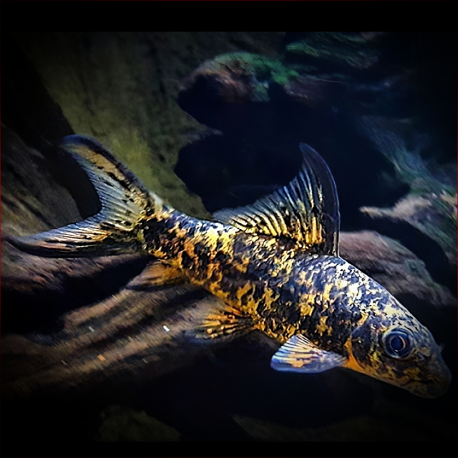More info
Datasheet
| Minimum Tank Size | 135 litres / 35.66 US gallons |
| Maximum Size | 16.3cm / 6.42inches |
| Temperature | 21°C / 69.80°F - 27°C / 80.60°F |
| Hardness | 3-15ºdH |
| pH | 6.0-7.5 |
Behaviour:
The Harlequin Shark is not suitable for general community aquariums due to its territorial nature, which escalates as they mature, leading to aggression towards similar-looking species. They are unsuitable for group setups as they prefer solitary lifestyles, with intraspecific aggression being prominent, often resulting in torn fins. In a large tank with adequate hiding spots, cohabitation may be possible, but each fish requires a territory of at least a meter in diameter.
Feeding and Diet:
Labeo species, primarily aufwuchs feeders, graze on submerged surfaces for algae, microscopic animals, and detritus. To enhance their colors and health, they should be fed small live and frozen foods like bloodworms, Daphnia, and Artemia, along with high-quality dried flakes, granules, and vegetable matter. Additionally, offering shelled peas, cucumber, spinach, and fruits is beneficial. In aquariums, they will feed midwater and browse biofilm on rocks.
Reproduction & Dimorphism:
Information on the breeding of the Harlequin Shark in aquariums is limited. Sexual dimorphism is challenging to determine, with females appearing thicker-bodied during spawning conditions. However, distinguishing between sexes is generally difficult in Labeo species.
Habitat and Distribution:
Primarily found in forest streams with dense marginal vegetation in the middle and lower Congo river basin, the Harlequin Shark resides in clear, tannin-colored waters with silt substrates and fallen organic debris. The species also inhabits the Ogooué drainage in Gabon, showcasing a high diversity of Labeo species in the Congo region.
Aquarium Setup:
Set up the aquarium like a flowing river with varied rocks, gravel, and large boulders, creating hiding places and a natural habitat. Although softer-leaved plants may be damaged, hardy options like Java fern, Bolbitis, or Anubias can be attached to decor. Bright lighting fosters biofilm growth for grazing. Compatible tankmates include active African characins and non-African cyprinids suited to similar conditions.

